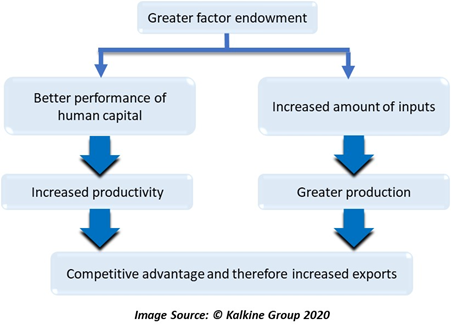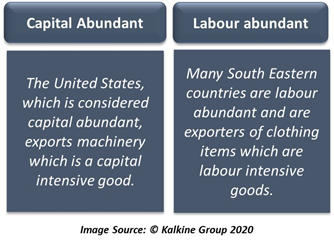What is meant by factor endowment?
Factor endowment refers to the factors of production that are available with a country to carry out production. Factor endowments differ from country to country and from territory to territory. Some countries may have more endowments of factors of productions while others may not have a lot of them.
These factors of production include land, labour, capital and entrepreneurship. They can be exploited for the manufacturing of goods and services. Thus, a nation with a higher level of factor endowment is wealthier than a nation with lesser factor endowment.
Abundance of resources may also help nations in achieving relative competitiveness and specialise in one good. Factor endowment is also sometimes referred to as factors of production. Both are similar; however, the term ‘endowment’ only refers to the quantity of the factors of production available with a nation.
Endowment refers to the quantity of any resource available to be utilised by individuals, firms, or nations. For an individual, endowment refers to the bequest left over by their parents, grandparents, or any family member after their demise.
How does a nation benefit from factor endowment?
Nations that are abundant in goods can benefit from them as they are inputs in the manufacturing of goods and services. With the availability of factor inputs, countries do not have to depend on imports to carry out production.

Also, countries that have land, labour and capital are more likely to see a better performance of human capital as well. Nations that are not wealthy are less likely to have proper educational institutions, healthcare services and the correct tools to aid the human capital. Therefore, factor endowments open many other channels that help in production.
Overall, this makes a country competitive and more self-sufficient rather than import dependent. It also enables the country to export to other nations at competitive levels.
What is the factor endowment theory?
Factor endowment theory depends on the fact that countries have different ratios of capital to labour. This difference in the ratios allows them to specialise in different goods. For instance, a country that has a higher ratio of capital to labour would be efficient in the production of capital-intensive goods. Similarly, countries that have a lesser ratio of capital to labour would be efficient in the production of labour-intensive goods.
This is called comparative advantage. As countries enjoy efficient production in one good, they can export it and they can simultaneously import the good in which they are inefficient.
Trade theory by Heckscher-Ohlin suggests that the cost of production differs across countries due to the difference in the supply of the factors of production. Hence, this theory suggests that there is no absolute advantage that countries enjoy, rather there is relative advantage which enables nations to export one good and import another.
Factor endowment ratios are prone to change. As countries advance it might be possible that countries gain advantage in goods that they were previously not advantaged in.
What are the problems with factor endowment theory?
Factor endowment theory only accounts for a small percentage of the world trade. For instance, consider the case of the United States and East Asia. Many East Asian countries are labour abundant, but they started growing at a much faster rate than the US. However, it was observed that as both started to become more like each other in terms of the availability of factors, trade grew between them. This is contradictory to the factor endowment theory.
This points to the fact that there are other factors influencing the trade between them rather than the availability of resources. Thus, factor endowment theory fails to apply to the practical world. It also does not account for the technological differences between two countries. Therefore, it is not the absolute basis of trade for countries.

However, the factor endowment theory is still applicable in some instances. For instance, countries that are abundant in labour like Bangladesh and India are high exporters of manufactured clothing, which is a labour intensive good. Similarly, Middle Eastern countries are abundant in oil and thus are major exporters of it. The US is considered as a capital abundant nation and thus it is efficient in the production of machinery and sees high exports of the same.
 Please wait processing your request...
Please wait processing your request...